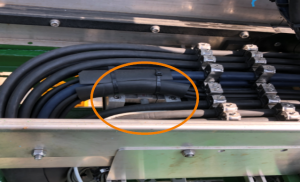Measure the tensile force in the energy chain with the aid of cables | i. Sense CF.P
igu-blog-adm | 15. January 2021
What is i. Sense CF.P?
The i. Sense CF.P system falls under the category of condition monitoring. The condition monitoring product range at igus goes by the name of i. Sense (derived from the English “I sense”). The area of condition monitoring forms part of the data foundation in the field of smart plastics. CF.P completes the product portfolio with the help of tensile force measurement on cables. Other products with similar functions are the push/pull detection EC. P and the break detection EC.B.
Why do you need tensile force monitoring for cables at all?
Due to the dynamics in applications of energy chains, high forces act not only on the energy chain but also on the cables. Over time, these forces ensure normal movement of the cables within the e-chain®. In this case, we only consider applications with appropriate strain relief on the cables. Despite proper strain relief, the laws of physics always win out after a while. Readjustment of the cables within the energy chain is necessary. The following image shows how the position of cables changes over time. The aim is to guide the cables in the neutral phase of the e-chain. They should not chafe on the inner or outer radius.

CF.P was developed precisely for the case where the cable scrapes against the inner radius of the energy chain, wears out and represents a safety risk for man and machine. We explain how it works in the next section.
How does tensile force measurement work on cables with i. Sense CF.P?
In a gliding application (energy chain glides on itself or on a glide bar in a guide trough) the cables are fixed at the fixed end by means of strain relief. When, as mentioned in the previous section, the cables rest against the inner radius of the e-chain®, this contact generates not only abrasion but also a tensile force on the cable. At the fixed end of the energy chain, a force sensor measures the tensile forces occurring on the cables and transmits these values to the CF.P module. An optical or acoustic signal is issued when previously set limit values are exceeded. If required, the system can also switch off completely. This very simple condition monitoring provides additional system safety and you never forget to readjust the cables again. All these little things actively extend product life and increase safety. The following video shows an animation of how it works.
What is the benefit of an i.Sense CF.P unit?
- Early detection of cable abrasion and avoidance
- of the high costs of production stoppages
- Easy retrofitting or general installation of the system
- Alerting or shutting down the system in case of emergency
- Storage of force measurement data on SD card
- Sensor data transmission to a UART interface is possible
Where is CF.P used?
The application areas of a CF.P module are predominantly all applications in which the energy chain is installed in a gliding form, as the displacements of the cables are strongest here. By far the largest industrial sector for the CF.P system is crane construction, where every system failure is associated with high costs and the stress on the installed materials is very high.


